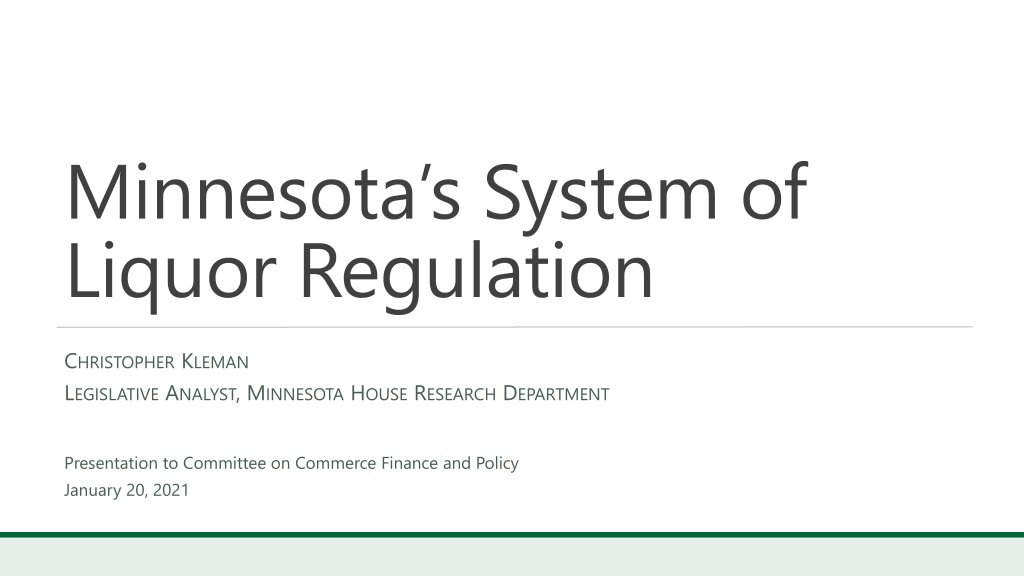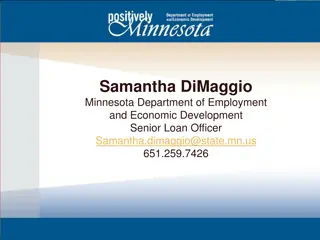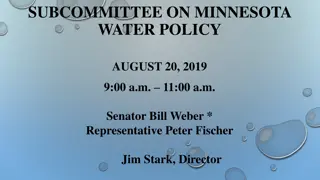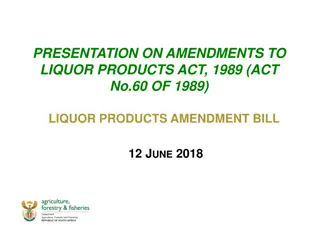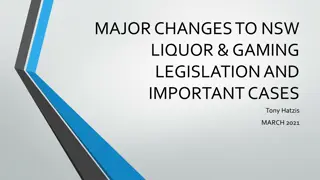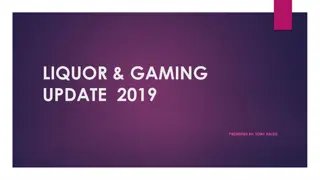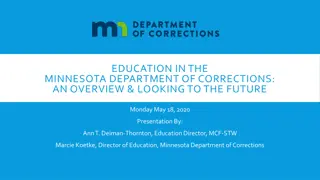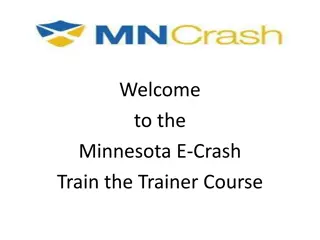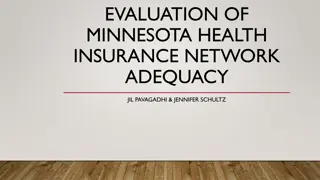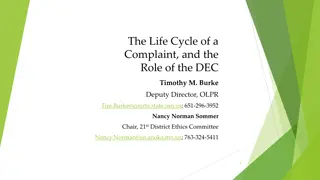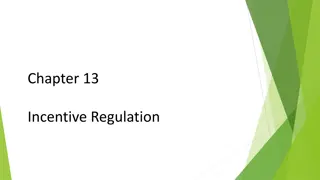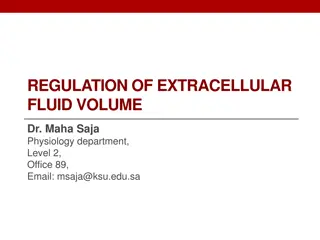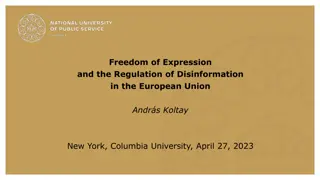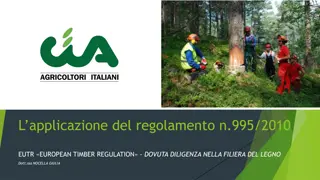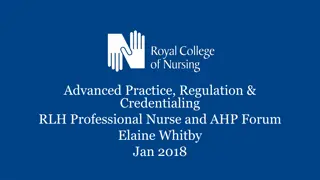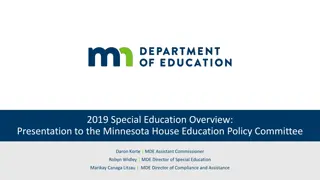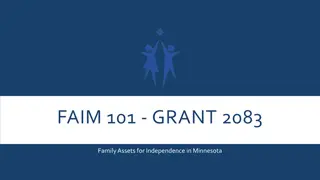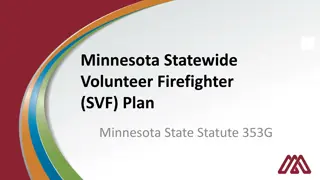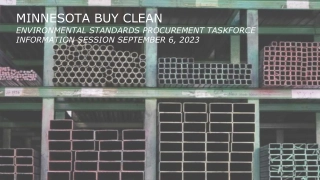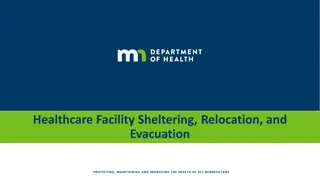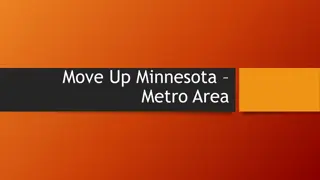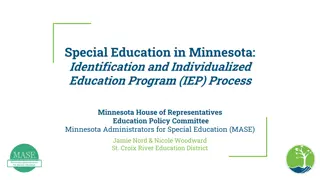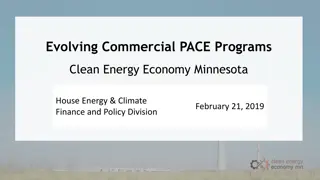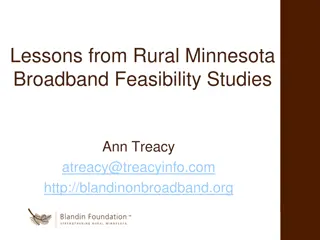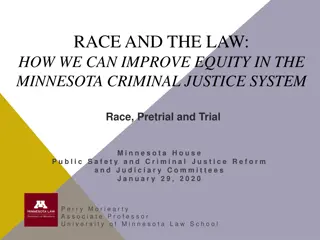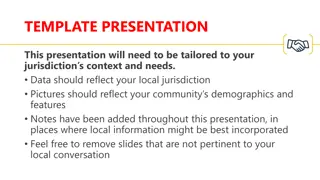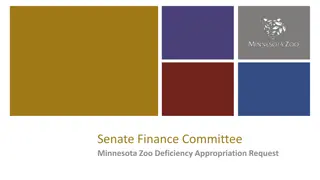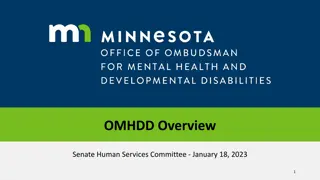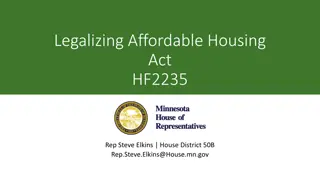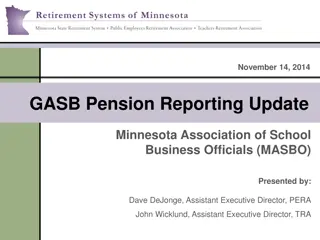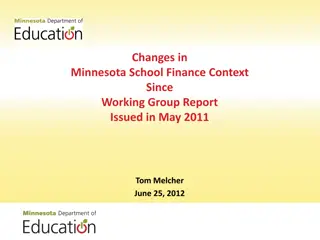Liquor Regulation in Minnesota: A Comprehensive Overview
Liquor regulation in Minnesota is governed by Chapter 340A, encompassing beer, wine, and spirits. Definitions of alcoholic beverages are provided, along with insights into the state and federal roles in regulation. The presentation also delves into the pre-prohibition era, highlighting the challenges posed by tied-houses and the perception of liquor consumption in society.
Download Presentation

Please find below an Image/Link to download the presentation.
The content on the website is provided AS IS for your information and personal use only. It may not be sold, licensed, or shared on other websites without obtaining consent from the author. Download presentation by click this link. If you encounter any issues during the download, it is possible that the publisher has removed the file from their server.
E N D
Presentation Transcript
Minnesotas System of Liquor Regulation CHRISTOPHER KLEMAN LEGISLATIVE ANALYST, MINNESOTA HOUSE RESEARCH DEPARTMENT Presentation to Committee on Commerce Finance and Policy January 20, 2021
House Research Department Christopher Kleman, liquor analyst Christopher.Kleman@house.mn Patrick McCormack Patrick.McCormack@house.mn House Research website: https://www.house.leg.state.mn.us/hrd/ Nonpartisan staff provides bill and amendment development and drafting, legal and policy analysis 2 MINNESOTA'S SYSTEM OF LIQUOR REGULATION | MINNESOTA HOUSE RESEARCH DEPARTMENT
Definitions Chapter 340A is entitled Liquor, which encompasses beer, wine, and spirits Alcoholic beverage1 Any beverage containing more than 0.5% alcohol by volume (ABV) Malt liquor A beverage made from malt by fermentation, i.e. beer Wine A product made from fermented grapes or other agricultural products, including vermouth, cider, and sake, but not distilled spirits Distilled spirits Ethyl alcohol, spirits of wine, whiskey, rum, brandy, gin, including all dilutions and mixtures Off-sale Sales for consumption off the premises (liquor stores) On-sale Sales for consumption on the premises (restaurants) 1. Statutory definitions on this slide are found in Minnesota Statutes, section 340A.101, subds. 2 (alcoholic beverage), 9 (distilled spirits), 16 (malt liquor), 20 (off-sale), 21 (on-sale). and 29 (wine). 3 MINNESOTA'S SYSTEM OF LIQUOR REGULATION | MINNESOTA HOUSE RESEARCH DEPARTMENT
State and federal role in regulation 21st amendment The transportation or importation into any State, Territory, or Possession of the United States for delivery or use therein of intoxicating liquors, in violation of the laws thereof, is hereby prohibited. Importation requires a license in Minnesota including e-commerce (although some personal use exceptions exist) 1 Liquor must come to rest with a licensed wholesaler Very little federal regulation of interstate commerce in liquor Federal regulation includes numerous permits and labeling requirements (via the Tobacco Tax and Trade Bureau or TTB) Constitutional law limits States cannot favor in-state economic interests of alcoholic beverage producers (e.g. Bacchus Imports, LTD. v. Dias, 468 U.S. 263 (1984) and Granholm v. Heald 544 U.S. 460 (2005)) Tension between state authority under 21st amendment and commerce clause 1. Minnesota Statutes, section 340A.302 4 MINNESOTA'S SYSTEM OF LIQUOR REGULATION | MINNESOTA HOUSE RESEARCH DEPARTMENT
Pre-prohibition era Tied-houses Vertically integrated manufacturers held interest in liquor retailers Sales incentives of saloons encouraged overconsumption Exclusive retailer arrangements Tied houses, that is establishments under contract to sell exclusively the product of one manufacturer, were, in many cases, responsible for the bad name of the saloon. The tied house system had all the vices of absentee ownership. The manufacturer knew nothing and cared nothing about the community. All he wanted was increased sales. 1 Perception that drinking caused significant social harm created opposition to the liquor business Every inebriate is either a potential criminal, a burden upon public funds, a danger to himself or others, or a cause of distress, terror, scandal, or nuisance, to his family and to those with whom he associates. 2 1. Michael B. Newman and Jason H. Barker, Retying the House: How the Evolution of Prohibition Era Alcohol Beverage Laws Has Facilitated a Generation of Independent Craft Brewers, Buffalo Intellectual Property Law Journal, volume 12, no. 1, page 162 (2018) (quoting Raymond Fosdick & Albert Scott, TOWARD LIQUOR CONTROL, 29 (1933)). (2018). 2. Johan Edman, Temperance and Modernity: Alcohol Consumption as a Collective Problem, 1885 1913, Journal of Social History, Volume 49, Issue 1, (2015) (quoting R. W. Branthwaite, Legislation for inebriates, in CP 1909, 250.) 5 MINNESOTA'S SYSTEM OF LIQUOR REGULATION | MINNESOTA HOUSE RESEARCH DEPARTMENT
Pre-prohibition era States struggled to regulate liquor Wilson Act (1890) All fermented, distilled, or other intoxicating liquors or liquids transported into any State or Territory or remaining therein for use, consumption, sale, or storage therein, shall upon arrival in such State or Territory be subject to the operation and effect of the laws of such State or Territory enacted in the exercise of its police powers, to the same extent and in the same manner as though such liquids or liquors had been produced in such State or Territory, and shall not be exempt therefrom by reason of being introduced therein in original packages or otherwise.1 1. 27 U.S. Code 121 6 MINNESOTA'S SYSTEM OF LIQUOR REGULATION | MINNESOTA HOUSE RESEARCH DEPARTMENT
Pre-prohibition era Webb-Kenyon Act (1913) The shipment or transportation, in any manner or by any means whatsoever, of any spirituous, vinous, malted, fermented, or other intoxicating liquor of any kind, from one State, Territory, or District of the United States, or place noncontiguous to but subject to the jurisdiction thereof, into any other State, Territory, or District of the United States, or place noncontiguous to but subject to the jurisdiction thereof, or from any foreign country into any State, Territory, or District of the United States, or place noncontiguous to but subject to the jurisdiction thereof, which said spirituous, vinous, malted, fermented, or other intoxicating liquor is intended, by any person interested therein, to be received, possessed, sold, or in any manner used, either in the original package or otherwise, in violation of any law of such State, Territory, or District of the United States, or place noncontiguous to but subject to the jurisdiction thereof, is prohibited.1 1. 27 U.S. Code 122 7 MINNESOTA'S SYSTEM OF LIQUOR REGULATION | MINNESOTA HOUSE RESEARCH DEPARTMENT
Prohibition 18th amendment (1920) Section 1. After one year from the ratification of this article the manufacture, sale, or transportation of intoxicating liquors within, the importation thereof into, or the exportation thereof from the United States and all territory subject to the jurisdiction thereof for beverage purposes is hereby prohibited. Section 2. The Congress and the several states shall have concurrent power to enforce this article by appropriate legislation. Section 3. This article shall be inoperative unless it shall have been ratified as an amendment to the Constitution by the legislatures of the several states, as provided in the Constitution, within seven years from the date of the submission hereof to the states by the Congress. 8 MINNESOTA'S SYSTEM OF LIQUOR REGULATION | MINNESOTA HOUSE RESEARCH DEPARTMENT
Prohibition Did not prohibit purchase and consumption which de facto allowed home production Does intoxicating liquors = alcoholic beverages ?1 Is 3.2 intoxicating liquor ? Volstead Act implemented prohibition. Named after U.S. House of Representatives chair of the judiciary committee Andrew Volstead from Minnesota. Born near Kenyon in Goodhue County and attended St. Olaf College Died in Granite Falls2 1. For a broader discussion of this topic, see Paul Aaraon and David Musto, Temperance and Prohibition in America: A Historical Overview, Alcohol and Public Policy: Beyond the Shadow of Prohibition (1981). 2. Source: https://history.house.gov/People/Listing/V/VOLSTEAD,-Andrew-John-(V000114)/ 9 MINNESOTA'S SYSTEM OF LIQUOR REGULATION | MINNESOTA HOUSE RESEARCH DEPARTMENT
Prohibition Concerns raised over intrusion into personal behavior, economic regulation, prohibition not working, organized crime, product safety Consumption may have decreased by 50%, due in part to increased prices1 Myths? Some of the claims contained in this litany are legends that can be quickly dismissed. Before the 18th Amendment, people were drinking more, not less. There is no convincing evidence that Prohibition brought on a crime wave; homicide had its highest rate of increase between 1900 and 1910; organized rackets, while expanding to take advantage of new opportunities, had been firmly established in urban areas before the 18th Amendment . . . . According to census statistics, the rate of death from wood or denatured alcohol remained almost constant from its peak year in 1920 of 369 . . . . 2 Federal liquor tax seen as needed response to great depression 1. See generally slide 8, note 1 2. Id. 10 MINNESOTA'S SYSTEM OF LIQUOR REGULATION | MINNESOTA HOUSE RESEARCH DEPARTMENT
Post-prohibition era 21st amendment ratified in 1933 Section 1. The eighteenth article of amendment to the Constitution of the United States is hereby repealed. Section 2. The transportation or importation into any state, territory, or possession of the United States for delivery or use therein of intoxicating liquors, in violation of the laws thereof, is hereby prohibited. Section 3. This article shall be inoperative unless it shall have been ratified as an amendment to the Constitution by conventions in the several states, as provided in the Constitution, within seven years from the date of the submission hereof to the states by the Congress. 11 MINNESOTA'S SYSTEM OF LIQUOR REGULATION | MINNESOTA HOUSE RESEARCH DEPARTMENT
Post-prohibition era How to solve the problems of the pre-prohibition era? Section 2 of the 21st amendment is the Webb-Kenyon Act Devolved federal control allowed states to adopt their own regulatory systems for liquor Control states state controls aspects of sale and distribution, including off- sale 3-tier system states separate industry into 3 regulated tiers In a pure 3-tier system: Manufacturers only sell to wholesalers Wholesalers only sell to retailers Retailers only sell to consumers 12 MINNESOTA'S SYSTEM OF LIQUOR REGULATION | MINNESOTA HOUSE RESEARCH DEPARTMENT
Minnesotas 3-tier system Severs link between manufacturers and retailers and limits vertical integration, but allows exceptions Each tier is licensed and regulated under chapter 340A Allows for taxation under the state s various liquor excise taxes Conventional wisdom is that a 3-tier system promotes administrability of regulatory system, safety of liquor supply, fairness in competition, harm reduction, greater control of social conditions (e.g. neighborhood impacts) Reforms in the 1970s (the Coleman Act) reaffirmed the state s 3- tier system and balanced the interests of labor, wholesalers, retailers, and the public, which remains in some form to this day 13 MINNESOTA'S SYSTEM OF LIQUOR REGULATION | MINNESOTA HOUSE RESEARCH DEPARTMENT
Exceptions to the 3-tier system The state has a modified 3-tier system that allows a limited amount of vertical integration Conventional wisdom is that the 3-tier system creates barriers to entry and imposes regulatory costs on small producers (microbreweries, microdistilleries, wineries) Market shift in recent decades toward small producers In MN, small producers are sometimes allowed to sell directly to retailers and consumers based on the type of liquor manufactured and the size of the producer s operation 14 MINNESOTA'S SYSTEM OF LIQUOR REGULATION | MINNESOTA HOUSE RESEARCH DEPARTMENT
Exceptions to the 3-tier system Microdistilleries (2014)1 May make retail sales but not self-distribute at wholesale Produces no more than 40,000 proof gallons per year Proof gallon means one gallon of 50% spirits at 60 degrees Fahrenheit May sell on-sale liquor produced by the distillery at cocktail rooms May sell off-sale liquor produced on-site, limited to one 375 ml bottle per customer per day 1. See Minnesota Statutes, sections 340A.101, subd. 17a, and 340A.22 15 MINNESOTA'S SYSTEM OF LIQUOR REGULATION | MINNESOTA HOUSE RESEARCH DEPARTMENT
Exceptions to the 3-tier system Microbreweries no statutory definition License tiers by barrels produced per year: up to 2,000 (microbrewery); 2,000 3,500 (small brewer); over 3,500; separate brew pub license1 Brewpubs and breweries may produce beer Brewpubs may sell on-sale beer2 Brewpubs may sell off-sale beer produced on premises Off-sale must conform to growler rules, off-sale cannot exceed 750 barrels per year, total on- and off-sale may not exceed 3,500 barrels Cannot sell beer to wholesalers May obtain a full, on-sale intoxicating liquor license 1. Minnesota Statutes, section 340A.301, subd. 6 2. See Minnesota Statutes, section 340A.24 16 MINNESOTA'S SYSTEM OF LIQUOR REGULATION | MINNESOTA HOUSE RESEARCH DEPARTMENT
Exceptions to the 3-tier system Brewers May sell on-sale beer at a taproom (limit is 250,000 barrels/year)1 May sell off-sale beer in growlers (limit is 20,000 barrels/year)2 May self-distribute (limit is 20,000 barrels/year)3 May not obtain a full on-sale intoxicating liquor license but may sell to wholesalers 1. Minnesota Statutes, section 340A.26, subd. 2 2. Minnesota Statutes, section 340A.28 3. Minnesota Statutes, section 340A.301, subd. 9, para. (g) 17 MINNESOTA'S SYSTEM OF LIQUOR REGULATION | MINNESOTA HOUSE RESEARCH DEPARTMENT
Exceptions to the 3-tier system Farm wineries1 Operated by the owner of a Minnesota farm Located on agricultural land Majority of the ingredients must be grown in MN but waivers are available (provision not enforceable; see Alexis Bailly Vineyard, Inc. v. Harrington, No. 17-CV-0913 (WMW/HB), 2020 WL 5106789 (D. Minn. Aug. 31, 2020)) May sell on-sale wine May sell off-sale wine May self-distribute or sell to wholesalers May obtain a full on-sale intoxicating liquor license 1. See generally Minnesota Statutes, section 340A.315 18 MINNESOTA'S SYSTEM OF LIQUOR REGULATION | MINNESOTA HOUSE RESEARCH DEPARTMENT
3.2 beer 3.2 percent malt liquor is beer between .5 % ABV and 3.2% ABW (roughly 4% ABV)1 Is not defined as intoxicating liquor, which is liquor exceeding 3.2% ABV so provisions that apply to intoxicating liquor do not apply to 3.22 Off-sale 3.2 could be sold on Sunday prior to Sunday sales law Off-sale 3.2 may be sold at establishments other than exclusive liquor stores (e.g. grocery stores, convenience stores)3 Subject to labelling requirements4 Minnesota is the only remaining state with 3.2 laws 1. Minnesota Statutes, section 340A.101, subd. 19 2. Minnesota Statutes, section 340A.101, subd. 14 3. Minnesota Statutes, section 340A.403, subd. 1 4. Minnesota Statutes, section 340A.301, subd. 12 19 MINNESOTA'S SYSTEM OF LIQUOR REGULATION | MINNESOTA HOUSE RESEARCH DEPARTMENT
Local authority Municipalities enjoy significant authority to regulate liquor Municipal liquor stores may monopolize off-sale1 Can only be established in cities with a population of no more than 10,000 Subject to continuation provisions if operated at a loss Can be more restrictive2 Issues most but not all on- and off-sale licenses Some licenses are issued or approved by the commissioner of public safety (e.g. wine license or catering permit under section 340.404, subds. 5 and 12, consumption and display permits under section 340A.414) 1. Minnesota Statutes, section 340A.601 2. Minnesota Statutes, section 340A.509, but see A/Al, Inc. v. City of Faribault, 569 N.W.2d 546 (1997) (holding that this provision only authorized further restrictions on the sale of alcohol when there is no applicable state law governing sales) 20 MINNESOTA'S SYSTEM OF LIQUOR REGULATION | MINNESOTA HOUSE RESEARCH DEPARTMENT
Enforcement Local licensing jurisdictions and the commissioner of public safety may revoke or suspend certain licenses Buyer s card may be revoked or suspended by the commissioner under section 340A.301, subd. 7 Commissioner may revoke or suspend manufacturer, wholesaler, and importer licenses under section 340A.304 Local authorities and the commissioner have broad authority to revoke or suspend permits and licenses for violations under section 340A.415 Also zoning and other ordinances, criminal prosecution, civil penalties Alcohol and Gambling Enforcement division of the Department of Public Safety conducts investigations and inspections, and issues fines. 21 MINNESOTA'S SYSTEM OF LIQUOR REGULATION | MINNESOTA HOUSE RESEARCH DEPARTMENT
Dram shop liability Personal injury liability - Statutory right of action against any person who illegally sold alcoholic beverages to an individual who then became intoxicated and caused harm.1 All liquor retailers must purchase insurance to cover these liabilities2 Does not apply to small retail operations 3.2 retailers (on-sale < $25,000; off-sale < $50,000) Wine licenses < $25,000 Holders of temporary wine licenses 1. Minnesota Statutes, section 340A.801 2. Minnesota Statutes, section 340A.409 22 MINNESOTA'S SYSTEM OF LIQUOR REGULATION | MINNESOTA HOUSE RESEARCH DEPARTMENT
Recent legislation Sunday sales passed in 20171 COVID relief allowed some on-sale licensees to make limited off-sales1 Restaurants may sell limited quantities of off-sale malt liquor, hard seltzer, cider, and wine with food takeout orders Expires when executive order closing places of public accommodation due to COVID-19 ends Some breweries and brewpubs may sell off-sale growlers under current law however Special local liquor laws provide narrow exceptions to statutes, ordinances, or charter provisions 2020 omnibus liquor bill3 1. Minnesota Laws 2017, chapter 6 2. Minnesota Laws 2020, chapter 75 3. Minnesota Laws 2020, chapter 103 23 MINNESOTA'S SYSTEM OF LIQUOR REGULATION | MINNESOTA HOUSE RESEARCH DEPARTMENT
Resources House research special liquor law lookup tool: https://www.house.leg.state.mn.us/hrd/liquor.aspx House research publications on liquor covering state fair service, farm wineries, importation for personal use, wine tasting and sampling, and Minnesota s 3-tier system: https://www.house.leg.state.mn.us/hrd/topics.aspx?topic=3 Alcohol and Gambling Enforcement: https://dps.mn.gov/divisions/age/Pages/default.aspx Christopher.Kleman@house.mn 24 MINNESOTA'S SYSTEM OF LIQUOR REGULATION | MINNESOTA HOUSE RESEARCH DEPARTMENT
Questions? Minnesota House Research Department provides nonpartisan legislative, legal, and information services to the Minnesota House of Representatives. www.house.mn/hrd | 651-296-6753 | State Office Building | St. Paul, MN 55155 25 MINNESOTA'S SYSTEM OF LIQUOR REGULATION | MINNESOTA HOUSE RESEARCH DEPARTMENT
